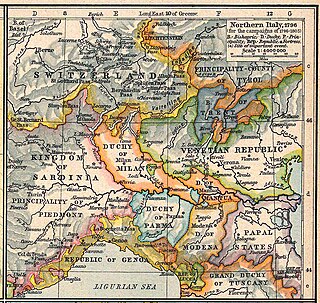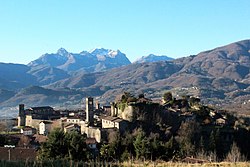
Montalcino is a hill town and comune in the province of Siena, Tuscany, central Italy.

Lucca is a city and comune in Tuscany, Central Italy, on the Serchio River, in a fertile plain near the Ligurian Sea. The city has a population of about 89,000, while its province has a population of 383,957.
The Garfagnana is a historical and geographical region of central Italy, today part of the province of Lucca, in Tuscany. It is the upper valley or basin of the river Serchio, and thus lies between the main ridge of the Northern Apennines to the north-east and the Alpi Apuane to the west. The principal towns are Castelnuovo di Garfagnana and Barga.

Iseo is a town and comune in the province of Brescia, in Lombardy, Italy, on the south shore of Lake Iseo. It is bounded by the communes of Provaglio d'Iseo, Sulzano, Polaveno and Paratico.

Montagnana is a town and comune in the province of Padova, in Veneto. Neighbouring communes are Borgo Veneto, Casale di Scodosia, Urbana, Bevilacqua, Pojana Maggiore, Pressana, Minerbe and Roveredo di Guà. As of 2017, the population of Montagnana is 9120. The town was awarded with the Bandiera arancione and is one of I Borghi più belli d'Italia.

The province of Lucca is a province in the Tuscany region of Italy. Its capital is the city of Lucca.

Barga is a medieval town and comune of the province of Lucca in Tuscany, central Italy. It is home to around 10,000 people and is the chief town of the "Media Valle" of the Serchio River. It is one of I Borghi più belli d'Italia.

The Serchio is the third longest river in the Italian region of Tuscany at 126 kilometres (78 mi), coming after the Arno at 242 kilometres (150 mi) and the Ombrone, 161 kilometres (100 mi). By mean rate of flow, it is the second largest, smaller than Arno but larger than Ombrone.

Bagni di Lucca is a comune of Tuscany, Italy, in the Province of Lucca with a population of about 6,100. The comune has 27 named frazioni (wards).

Castelnuovo di Garfagnana is a town and comune in the province of Lucca, Toscana, central Italy. It is located at the confluence of the Serchio and the Turrite Secca rivers, close to the intersection of roads passing through the Apennine Mountains and the Apuan Alps.

Fosciandora is a comune (municipality) of 554 inhabitants in the Province of Lucca in the Italian region Tuscany, located about 70 kilometres (43 mi) northwest of Florence and about 30 kilometres (19 mi) north of Lucca.

Gallicano is a comune (municipality) in the Province of Lucca in the Italian region Tuscany, located about 70 kilometres (43 mi) northwest of Florence and about 25 kilometres (16 mi) northwest of Lucca.

Piazza al Serchio is a comune (municipality) in the Province of Lucca in the Italian region Tuscany, located about 90 kilometres (56 mi) northwest of Florence and about 40 kilometres (25 mi) northwest of Lucca.
Firenzuola is a comune (municipality) in the Metropolitan City of Florence, in the Italian region Tuscany, located about 40 kilometres (25 mi) northeast of Florence.

Bibulca Way was an old road dating back to the 11th century that used to link up Modena with Lucca and it was part of a much bigger network of roads. It starts where the Dragone River flows into the Dolo River in the La Piana locality and finishes at San Pellegrino in Alpe, a hamlet located on the ridge that separates the Tuscan from the Emilian Apennines. It was also called the Imperial Way due to its high toll that had to be paid in order to use it and that it could host a cart drawn by two oxen one beside the other, a luxury for the time. It has a length of 30 kilometers, starting from a height of 360 metres and arriving at a height of 1,529 metres. Now it is used as an amateur trekking path that runs alongside the Strada provinciale 32MO road and in certain stretches shares the same route.

Lugliano is a small frazione (village) located in the municipality of Bagni di Lucca, in the Province of Lucca, Tuscany.

The Santuario di San Pellegrino in Alpe or Santi Pellegrino e Bianco is a Roman Catholic church and adjacent hostel-hospital complex on a hilltop within the town limits of Castiglione di Garfagnana, province of Lucca, region of Tuscany, Italy. It lies in a rural site along the Bibulca Way.
San Pellegrino may refer to:


















